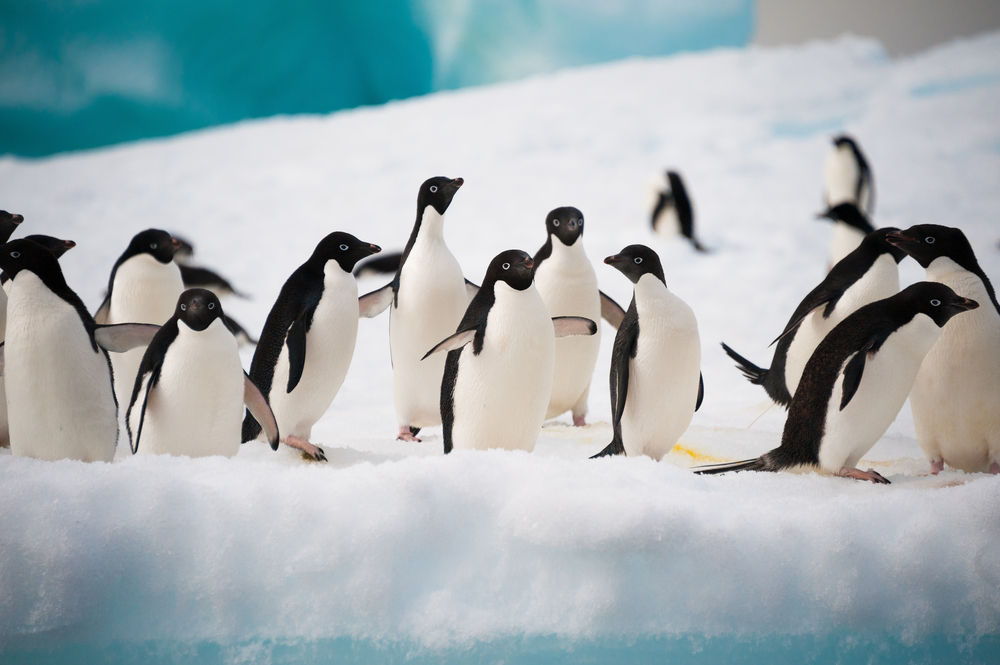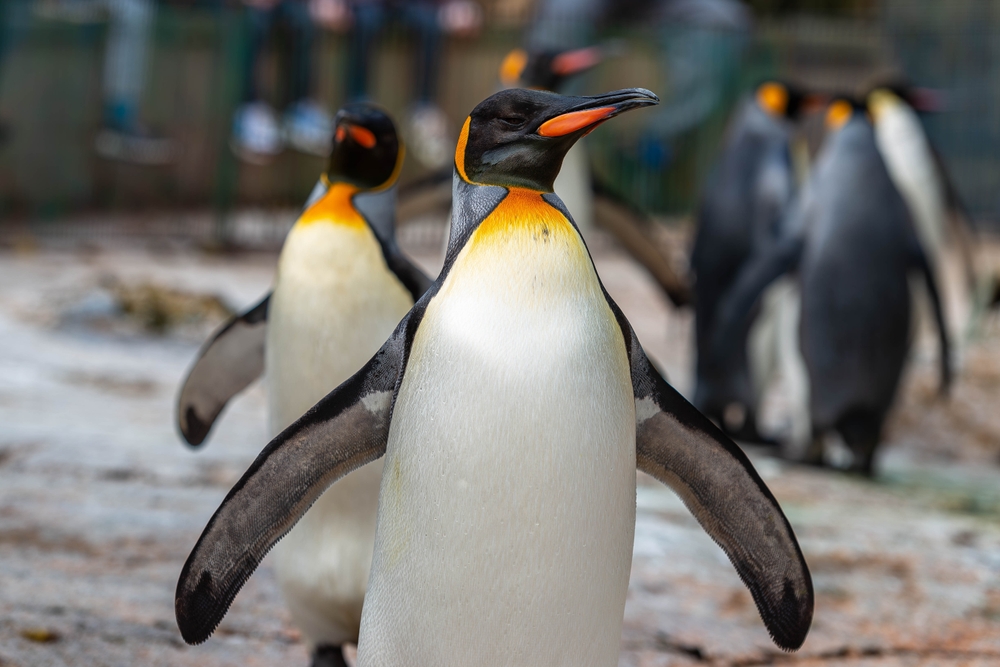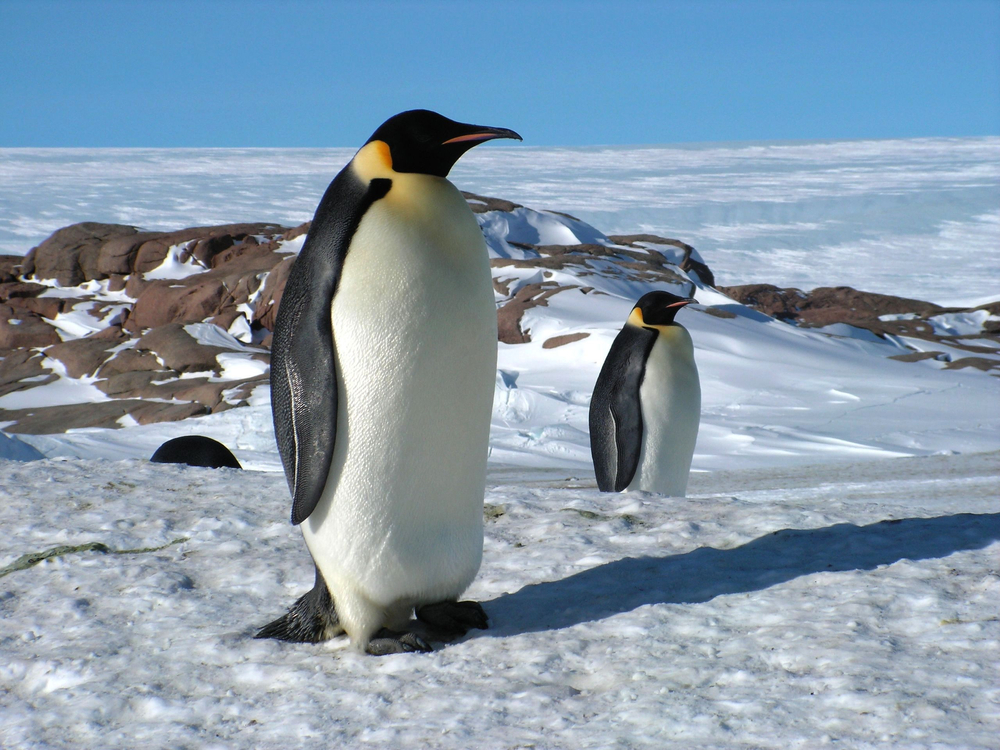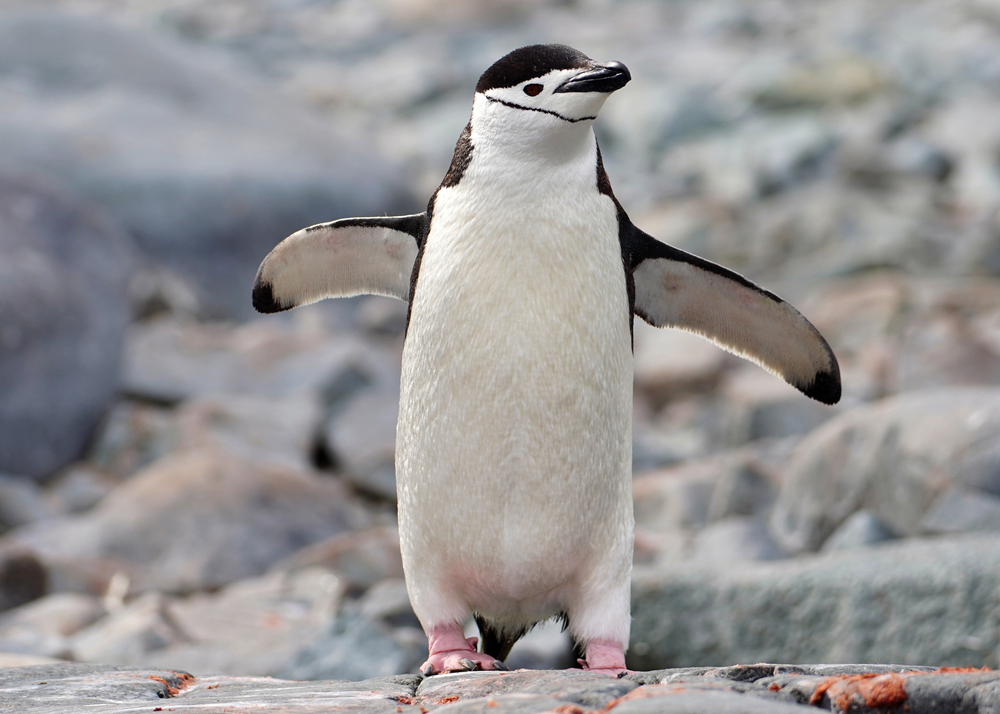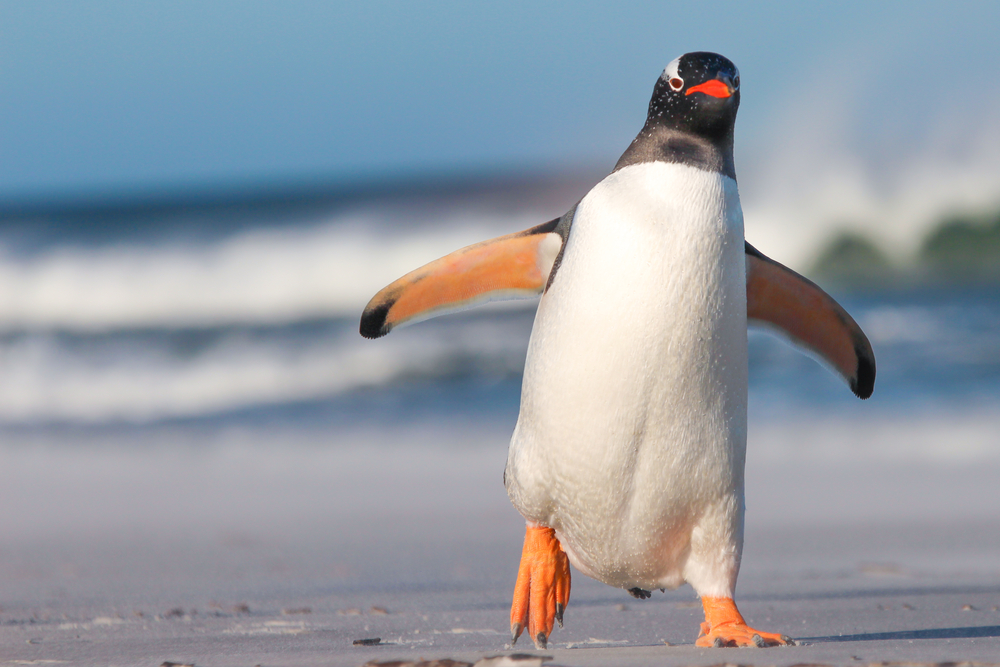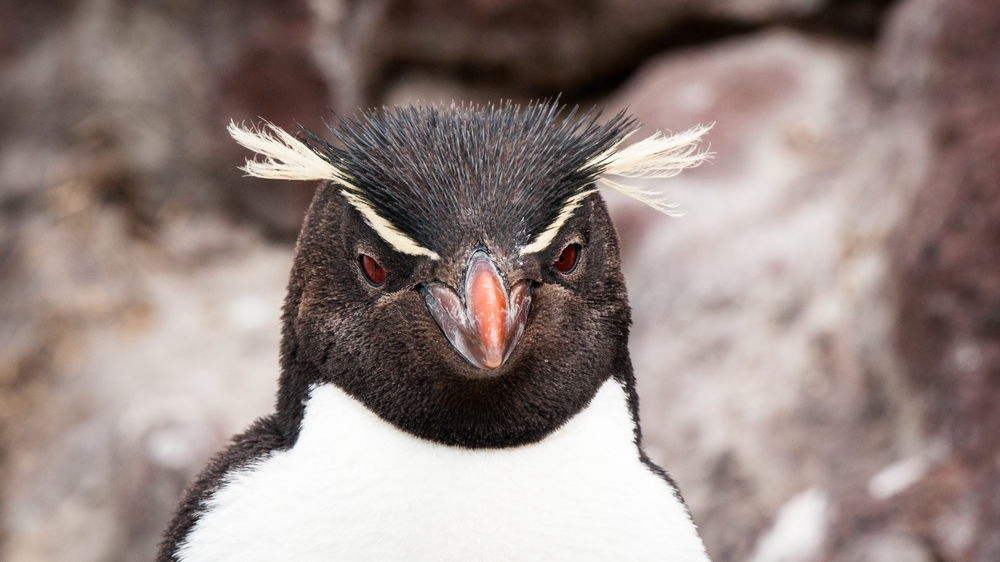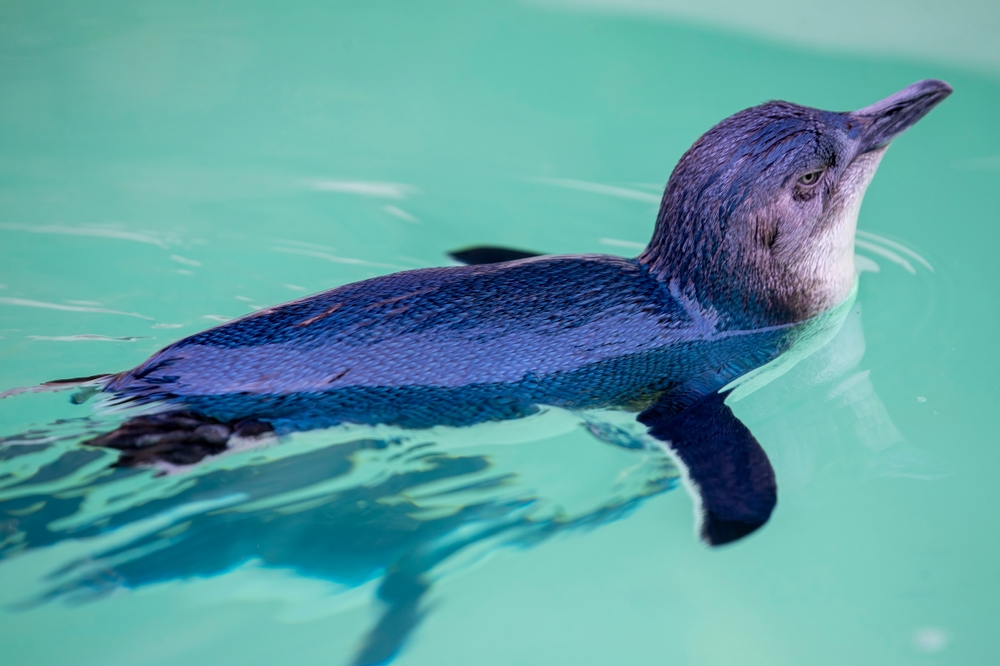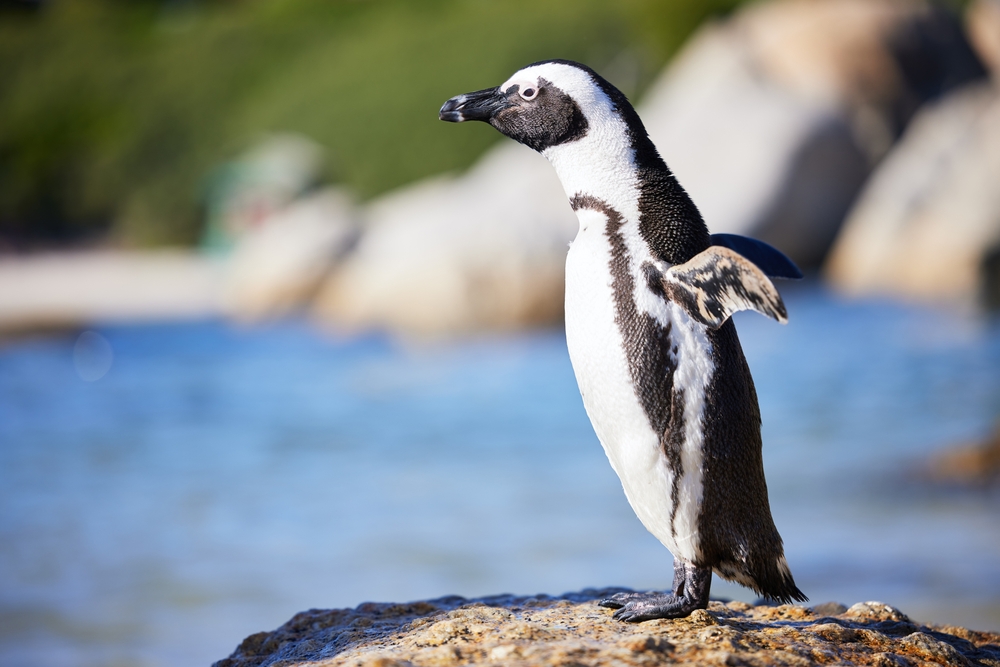The Adélie Penguin’s closest relatives are the other two members of the genus Pygoscelis: the Chinstrap Penguin(Pygoscelis antarcticus) and the Gentoo Penguin (Pygoscelis papua). Together, these three are often called the “brush-tailed penguins” due to their distinctive stiff tail feathers.
About
The Adélie Penguin (Pygoscelis adeliae) is a hardy Antarctic seabird in the Spheniscidae family, named after Adélie Land in Antarctica by French explorer Jules Dumont d’Urville, who honored his wife Adèle. It is one of the most widespread penguin species, inhabiting the entire Antarctic coastline and nearby islands, where vast breeding colonies can number in the hundreds of thousands.
Small to medium in size, Adélie Penguins stand about 70 centimeters (27 inches) tall and weigh between 3.5 and 6 kilograms (8 to 13 pounds), with seasonal weight changes depending on breeding and feeding cycles. They are instantly recognizable by their classic black-and-white “tuxedo” plumage and distinctive white eye ring, which sets them apart from other penguin species.
These penguins are superb swimmers, capable of reaching speeds up to 15 km/h (9 mph) while pursuing prey underwater. Their diet consists mainly of krill, supplemented by fish and squid, making them crucial players in the Antarctic marine food web. During the non-breeding season, Adélies spend months at sea, covering great distances across the Southern Ocean in search of food.
Breeding occurs during the short Antarctic summer, when colonies gather on ice-free rocky shores. Males build nests out of pebbles, which they defend vigorously. Females typically lay two eggs, with both parents sharing incubation duties and chick-rearing responsibilities. Despite the harsh conditions, their synchronized breeding and group living provide protection against predators such as skuas and leopard seals.
Currently listed as Least Concern, Adélie Penguins maintain stable overall populations, though climate change and shifting sea ice patterns affect food availability and breeding success in some regions.
As enduring symbols of Antarctica, Adélie Penguins embody resilience, cooperation, and adaptability, thriving in one of the planet’s most extreme environments.
Physical Characteristics
Adélie Penguins are small, robust Antarctic penguins recognized for their striking black-and-white plumage:
-
Coat/Plumage: Their feathers are dense and waterproof, providing insulation against extreme cold. They have a black head, back, and flippers, with a pure white belly and chest. A distinct white ring encircles each eye, giving them a sharp, expressive look.
-
Face: The head is entirely black except for the white eye ring. Their short bill is mostly black but partly hidden by feathers at the base.
-
Body: Compact and streamlined, adapted for efficient swimming. Their body is stocky, aiding in heat retention, and they have strong flippers for propulsion underwater.
-
Tail: Stiff and wedge-shaped, often used as a support when moving across ice.
-
Feet: Pale pink with strong black claws, adapted for both swimming and waddling across icy terrain.
Size:
-
Length (Body): About 18 to 28 in (46 to 71 cm).
-
Weight: Ranges between 7.9 to 13.2 lbs (3.6 to 6 kg), with males typically larger than females.
Adélie Penguins’ physical build is a product of survival in the harsh Antarctic environment. Their waterproof plumage, thick layer of insulating fat, and strong flippers make them powerful swimmers capable of diving up to 575 ft (175 m) in search of food.
Reproduction
The reproductive cycle of Adélie Penguins is closely tied to the Antarctic summer and the availability of ice-free nesting sites.
-
Mating and Courtship:
-
Adélie Penguins are seasonal breeders, returning to the same nesting colonies each year during October and November.
-
Courtship involves displays such as head-bobbing, flipper-waving, and vocal calls. Many pairs reunite with the same mate from previous seasons, demonstrating a high degree of fidelity.
-
-
Nesting:
-
They build simple nests out of stones on ice-free rocky ground. Stones are carefully collected and sometimes stolen from neighbors, a behavior common in dense colonies.
-
Nests are arranged in large colonies that can number in the tens of thousands.
-
-
Egg Laying and Incubation:
-
The female typically lays two eggs per season.
-
Both parents share incubation duties, alternating shifts of about 7–10 days while the other feeds at sea.
-
Incubation lasts around 32 to 34 days.
-
-
Chick Development:
-
Chicks hatch covered in soft gray down and weigh about 3–4 oz (85–115 g).
-
They are brooded under the parents’ warm bodies until strong enough to withstand the cold, usually within 2–3 weeks.
-
Both parents regurgitate food to feed their young.
-
-
Crèche and Independence:
-
After about 3 weeks, chicks gather in groups called crèches for protection, while parents continue to feed them.
-
At around 7 to 9 weeks, chicks fledge, replacing down with waterproof feathers, and head out to sea to become independent.
-
Adélie Penguins’ synchronized breeding cycle and shared parental roles are key to their survival in the severe Antarctic climate. High chick mortality can occur due to harsh weather, predation by skuas, or limited food availability.
Lifespan
Adélie Penguins are resilient seabirds that endure some of the harshest living conditions on Earth. Their lifespan varies between wild populations and those under managed care.
-
Lifespan in the Wild:
Adélie Penguins generally live 10 to 15 years in their natural Antarctic habitat. Survival rates are heavily influenced by environmental conditions, food availability, and predation. Many chicks and juveniles do not survive their first year, making adulthood a significant milestone. -
Lifespan in Captivity:
While Adélie Penguins are rarely kept in captivity due to their specialized needs, individuals under managed care with proper diet and veterinary attention may live slightly longer, sometimes exceeding 20 years.
Threats to the Adélie Penguin:
-
Climate Change: Shifts in sea ice patterns impact their breeding colonies and reduce access to feeding grounds, threatening chick survival.
-
Predation: Eggs and chicks are vulnerable to predation by skuas, giant petrels, and sheathbills. Leopard seals also prey on adults in the water.
-
Food Availability: Fluctuations in krill and fish populations, often linked to overfishing and changing ocean conditions, can reduce their primary food sources.
-
Human Disturbance: Although largely protected, human activity near colonies can disrupt breeding success.
Conservation measures, including international protection under the Antarctic Treaty System and monitoring of krill fisheries, are crucial for maintaining healthy Adélie Penguin populations. Their presence and breeding success also serve as important indicators of the overall health of the Antarctic ecosystem.
Eating Habits
Adélie Penguins are carnivorous seabirds with a diet closely tied to the rich, cold waters of the Southern Ocean.
-
Diet:
Their primary food source is Antarctic krill, along with small fish and squid. During the breeding season, krill makes up the majority of their diet, while fish (such as Antarctic silverfish) become more important at other times of the year. -
Foraging Strategy:
Adélie Penguins are agile hunters that rely on pursuit-diving. They swim swiftly underwater using their strong flippers, often reaching depths of 150 to 575 ft (45 to 175 m), though most dives are shallower and last less than 2 minutes. -
Hunting Behavior:
They forage in large groups, which provides safety in numbers and increases feeding efficiency. Group diving often stirs up prey, making it easier for many penguins to capture food at once. -
Feeding the Young:
Adults return from the sea with partially digested food stored in their stomachs, which they regurgitate to feed their chicks. This shared parental feeding is crucial to chick survival. -
Seasonal Variation:
The proportion of krill, fish, and squid in their diet changes depending on location, season, and prey availability. In years when sea ice conditions reduce krill abundance, chick survival rates can decline sharply.
Adélie Penguins’ eating habits are vital to the Antarctic food web. Their reliance on krill also links them to broader environmental changes, as fluctuations in sea ice and commercial fishing can directly impact their ability to feed themselves and their offspring.
Uniqueness
The Adélie Penguin (Pygoscelis adeliae) is one of the most iconic Antarctic seabirds, distinguished by several remarkable traits that set it apart:
-
True Antarctic Specialists: Unlike many penguin species that inhabit sub-Antarctic islands or temperate zones, Adélies are found almost exclusively along the Antarctic coastline, enduring some of the harshest conditions on Earth.
-
White Eye Ring: Their distinctive white ring around the eye gives them a sharp, wide-eyed appearance unique among penguins.
-
Massive Colonies: Adélie Penguins nest in colonies that can number in the hundreds of thousands, creating one of the largest bird gatherings in the world.
-
Stone Nest Builders: They construct simple nests from small stones, which are often stolen from neighbors in competitive displays of resourcefulness and persistence.
-
Synchronized Breeders: Breeding is highly synchronized within colonies, with most pairs laying eggs and raising chicks on nearly the same schedule, an adaptation that improves chick survival.
-
Exceptional Swimmers: Though only about 18 to 28 in (46 to 71 cm) tall, Adélie Penguins are powerful divers, capable of reaching depths of 575 ft (175 m) in pursuit of prey.
-
Climate Indicators: Because their survival depends on sea ice conditions and krill abundance, Adélie Penguins are considered key indicator species for the health of the Antarctic ecosystem.
-
Historic Significance: They were first described during the 1840 French Antarctic expedition and named after Adélie Land, itself named for the wife of explorer Jules Dumont d’Urville.
The Adélie Penguin’s adaptations for extreme cold, unique breeding behaviors, and ecological importance make it one of the most remarkable penguin species in the world.
Be the First to Share Photos of This Species.
FAQ’s
1. What is the species closest to the Adélie Penguin?
2. How does the Adélie Penguin compare to other penguins?
Adélie Penguins are smaller than Emperor or King Penguins but larger than the Little Blue Penguin. Unlike temperate penguin species, Adélies are true Antarctic specialists, nesting exclusively on the continent’s rocky coastline. Their synchronized breeding and massive colonies—sometimes numbering hundreds of thousands—make them among the most social and cold-adapted of all penguins.
3. What national parks provide an opportunity to see the Adélie Penguin?
Adélie Penguins are best observed in Antarctica’s protected areas, particularly within:
-
Ross Sea Region Marine Protected Area (Antarctica) – home to some of the largest Adélie colonies.
-
Antarctic Specially Protected Areas (ASPAs) – several along the Antarctic Peninsula safeguard breeding grounds.
-
Mac. Robertson Land (near the Australian Antarctic Territory) – included within protected zones tied to Australia’s Antarctic conservation efforts.
Tourists who join Antarctic expeditions to regions like the Ross Sea, East Antarctica, or the Antarctic Peninsula often have opportunities to see Adélie Penguins in their natural colonies, though access is strictly regulated under the Antarctic Treaty System.



































































